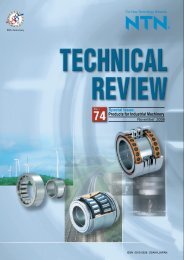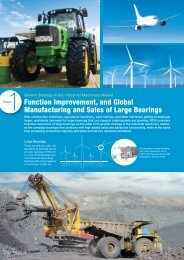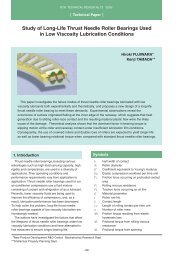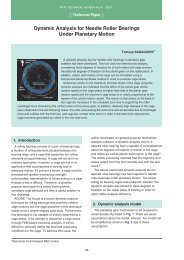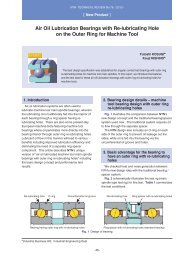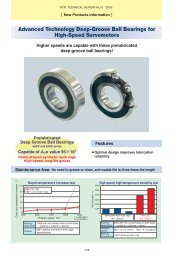High-speed Angular Contact Ball Bearings New 9 Series for ... - NTN
High-speed Angular Contact Ball Bearings New 9 Series for ... - NTN
High-speed Angular Contact Ball Bearings New 9 Series for ... - NTN
You also want an ePaper? Increase the reach of your titles
YUMPU automatically turns print PDFs into web optimized ePapers that Google loves.
<strong>NTN</strong> TECHNICAL REVIEW No.782010<br />
<strong>New</strong> Product <br />
<strong>High</strong>-<strong>speed</strong> <strong>Angular</strong> <strong>Contact</strong> <strong>Ball</strong> <strong>Bearings</strong><br />
<strong>New</strong> 9 <strong>Series</strong> <strong>for</strong> Machine Tool<br />
Futoshi KOSUGI<br />
Many 9 series angular contact ball bearings are used <strong>for</strong> the main spindles of machine tools in<br />
Europe. However, demand <strong>for</strong> them has risen also in Japan recently. We improved the current<br />
design and developed new 9 series high-per<strong>for</strong>mance angular contact ball bearings.<br />
We introduce the features and the per<strong>for</strong>mance test data of these new 9 series high-<strong>speed</strong><br />
angular contact ball bearings in this report.<br />
1. Introduction<br />
In order to shorten lead time by addition of process<br />
integration capability, an increasing number of machine<br />
tool models have recently been adopting unique main<br />
spindles whose angle can be varied during machining<br />
operation, and examples of such main spindles include<br />
milling main spindles on 5-axis machine tools and<br />
combined machine tools.<br />
Main spindles on these machines swing to change<br />
their angle, and a sufficiently large space is needed on<br />
these machine tools to accommodate the motion of<br />
main spindles. There<strong>for</strong>e, any main spindle in these<br />
machines needs to be compact in size, and the main<br />
spindle bearing also needs to be compact in size. For<br />
this reason, 9 series bearings are used because of<br />
their low cross-sectional heights and smaller width.<br />
This article hereunder describes the features and<br />
per<strong>for</strong>mance of the <strong>NTN</strong>’s newly developed “high<strong>speed</strong><br />
angular contact ball bearing 9 series” products.<br />
2. Advantages of 9 <strong>Series</strong> bearings<br />
Fig. 1 provides in<strong>for</strong>mation that helps clarify the<br />
advantages of 9 series bearings in comparison with 0<br />
series bearings. Because of lower cross-sectional<br />
height, 9 series bearings have the following<br />
advantages over 0 series bearings:<br />
• When main spindle diameter (bearing bore<br />
diameter) is same with both series (Fig. 1a) <strong>for</strong> a<br />
given main spindle diameter, a bearing product of<br />
smaller outside diameter may be used. Thus, a more<br />
compact gearbox design is possible, which leads to<br />
size reduction <strong>for</strong> main spindle.<br />
• When bearing outside diameter is same with both<br />
series (Fig. 1b)<br />
In an application where there is limitation on the<br />
bearing outside diameter dimension, use of a 9<br />
series bearing can lead to larger main spindle<br />
diameter. This feature will allow a main spindle<br />
design that provides greater shaft rigidity.<br />
0 series 9 series 0 series<br />
9 series<br />
a) Comparison <strong>for</strong> same shaft diameter (bearing bore diameter) b) Comparison <strong>for</strong> same bearing outside diameter<br />
Fig. 1 Feature of 9 series angular contact ball bearing<br />
Industrial Business HQ. Industrial Engineering Dept.<br />
-50-
<strong>High</strong>-<strong>speed</strong> <strong>Angular</strong> <strong>Contact</strong> <strong>Ball</strong> <strong>Bearings</strong> <strong>New</strong> 9 <strong>Series</strong> <strong>for</strong> Machine Tool<br />
On the disadvantage side, having balls smaller than<br />
those of 0 series, 9 series bearings are inferior to 0<br />
series bearings in terms of their radial load capacity<br />
and maximum allowable axial load. To eliminate this<br />
problem, <strong>NTN</strong> has developed 9 series bearing variants<br />
that boast greater load capacity.<br />
3. Improved functions on <strong>New</strong> 9 <strong>Series</strong><br />
products<br />
3.1 Load rating and allowable axial load<br />
Our newly developed high-<strong>speed</strong> angular contact<br />
ball bearing products—new 9 series—feature improved<br />
internal design that include rolling elements of<br />
increased diameter as shown in Fig. 2, thereby the<br />
load rating has been improved by a maximum of 50%<br />
and the allowable axial load has been increased by<br />
<strong>New</strong> design<br />
Old design<br />
Fig. 2 Design of new product<br />
20% (Fig. 3). Consequently, the new 9 series bearing<br />
products boast longer life and increased allowance<br />
against axial load that occurs during tool change<br />
process on machine tools; thus, these bearings will be<br />
used in a larger scope of applications.<br />
Fig. 4 provides axial rigidity graph and radial rigidity<br />
graph with high-<strong>speed</strong> angular contact ball bearings<br />
(new design and old design), internal bore diameter<br />
100 mm, with constant pressure preload (GN preload).<br />
3.2 Result of operation test<br />
The result of operation test with the high-<strong>speed</strong><br />
angular contact ball bearings (new design and old<br />
design) is described below.<br />
Fig. 5 schematically illustrates the construction of<br />
the test rig (main spindle type test rig) used <strong>for</strong> the test.<br />
Fig. 6 summarizes a result of temperature rise test<br />
on the new and old bearing design variants with<br />
ceramic balls, air-oil lubricated, and with fixed position<br />
preload.<br />
The pattern of heat rise on the outer ring of our new<br />
design, up to dmn = 1.4510 6 (12,000 min -1 ) is<br />
identical to that of the old design. However, at higher<br />
<strong>speed</strong> range, the temperature with the new design is<br />
somewhat higher (1 to 2˚C). A possible cause is a<br />
larger ball size, which leads to greater PV value<br />
(contact surface pressure x slip velocity).<br />
140<br />
Basic dynamic load rating Basic static load rating Allowable axial load<br />
120<br />
100<br />
<strong>New</strong> design<br />
Old design<br />
kN<br />
80<br />
60<br />
40<br />
20<br />
0<br />
50<br />
100 150 50 100 150 50 100 150<br />
Fig. 3 Basic load ratings and allowable axial load (steel ball, contact angle 20˚)<br />
15<br />
6<br />
Axial displacement μm<br />
10<br />
5<br />
<strong>New</strong> design<br />
Old design<br />
Radial displacement μm<br />
5<br />
4<br />
3<br />
2<br />
1<br />
<strong>New</strong> design<br />
Old design<br />
0<br />
0 500 1000 1500 2000 2500 3000<br />
Axial load N<br />
0<br />
0 500 1000 1500 2000 2500 3000<br />
Radial load N<br />
Fig. 4 Rigidity graph (bearing bore dia. 100 mm, constant pressure preload)<br />
-51-
<strong>NTN</strong> TECHNICAL REVIEW No.782010<br />
Fig. 7 graphically plots the variation in bearing<br />
preload in this test: the diagram shows that the new<br />
design helps reduce possible increase in preload by<br />
approximately 15% compared with the old design. To<br />
sum up, the temperature on outer ring on our new<br />
design is somewhat higher compared with the old<br />
design: nevertheless, our new design boasts improved<br />
anti-seizure property because temperature difference<br />
across its inner ring and outer ring is smaller,<br />
minimizing the increase in preload.<br />
Fig. 8 illustrates test result with constant pressure<br />
preload type bearing specimens.<br />
The temperature on the outer ring of our new design<br />
is higher by 1˚C compared with the old design:<br />
nevertheless, our new design is capable of stable<br />
operation up to ultrahigh-<strong>speed</strong> region of dmn = 2.40<br />
10 6 (20,000 min -1 ).<br />
Drive<br />
system<br />
Test bearing<br />
Preload N<br />
Temperature rise on outer ring ˚C<br />
5000<br />
4000<br />
3000<br />
2000<br />
1000<br />
20<br />
18<br />
16<br />
14<br />
12<br />
10<br />
8<br />
6<br />
4<br />
2<br />
<strong>New</strong> design<br />
Old design<br />
0<br />
0 5000 10000 15000<br />
Bearing running <strong>speed</strong> min -1<br />
5S-2LA-HSE920UDBP4 (<strong>New</strong> design)<br />
5S-2LA-HSE920DBP4 (Old design)<br />
Air-oil lubricated<br />
Air supply rate: 40 NL/min<br />
Oil supply rate: 0.03 mL/5 min<br />
Fixed position preload: 1800 N<br />
w/ jacket cooling<br />
<strong>New</strong> design<br />
Old design<br />
0<br />
0 5000 10000 15000 20000<br />
Bearing running <strong>speed</strong> min -1<br />
Approx. 15%<br />
reduction<br />
in increase<br />
in preload<br />
Fig. 7 Correlation between <strong>speed</strong> and preload<br />
Fig. 5 Test spindle<br />
Fig. 8 Test results (Constant pressure preload, Air-oil)<br />
Temperature rise on outer ring ˚C<br />
20<br />
18<br />
16<br />
14<br />
12<br />
10<br />
8<br />
6<br />
4<br />
2<br />
<br />
<strong>New</strong> design<br />
Old design<br />
5S-2LA-HSE920UDBP4 (<strong>New</strong> design)<br />
5S-2LA-HSE920DBP4 (Old design)<br />
Air-oil lubricated<br />
Air supply rate: 40 NL/min<br />
Oil supply rate: 0.03 mL/5 min<br />
Preload on mounted bearing: 49 N<br />
w/ jacket cooling<br />
0<br />
0 5000 10000 15000 20000<br />
Bearing running <strong>speed</strong> min -1<br />
Fig. 6 Test results (Fixed position preload, Air-oil)<br />
Temperature rise on outer ring ˚C<br />
<br />
20<br />
18<br />
16<br />
14<br />
12<br />
10<br />
8<br />
6<br />
4<br />
2<br />
0<br />
<strong>New</strong> design<br />
Old design<br />
2LA-HSE920UDBP4 (<strong>New</strong> design)<br />
2LA-HSE920DBP4 (Old design)<br />
Grease lubrication<br />
Prefilled grease: SE-1<br />
Fixed position preload: 49 N<br />
w/ jacket cooling<br />
0 5000 10000 15000<br />
Bearing running <strong>speed</strong> min -1<br />
Fig. 9 Test results (Fixed position preload, Grease)<br />
-52-
<strong>High</strong>-<strong>speed</strong> <strong>Angular</strong> <strong>Contact</strong> <strong>Ball</strong> <strong>Bearings</strong> <strong>New</strong> 9 <strong>Series</strong> <strong>for</strong> Machine Tool<br />
Fig. 9 summarizes test result with grease-lubricated<br />
specimens having steel balls, with fixed position<br />
preload setting. Even under these conditions, heat rise<br />
on the outer ring of the new bearing design remains<br />
low up to dmn = 1.4410 6 (12,000 min -1 ).<br />
4. Conclusion<br />
Compared with old products, our newly developed<br />
high-<strong>speed</strong> angular contact ball bearing 9 series<br />
products boast greater radial load capacity and<br />
allowable axial load, and longer life and increased load<br />
capacity during tool change process on machine tools.<br />
In terms of functions, the bearing temperature on our<br />
new design is 1 to 2˚C higher compared with old<br />
design. Nevertheless, the temperature gradient across<br />
the inner ring and outer ring on our new design is low<br />
and increase in preload in high-<strong>speed</strong> bearing<br />
operation is also low. Thus, our new design excels in<br />
anti-seizure property.<br />
<strong>NTN</strong> will add its “high-<strong>speed</strong> angular contact ball<br />
bearing new 9 series” products, which boast compact<br />
size and enhanced functionality, to its ULTAGE <strong>Series</strong><br />
line of products, and will actively market these novel<br />
products.<br />
Photo of author<br />
Futoshi KOSUGI<br />
Industrial Business HQ<br />
Industrial Engineering Dept.<br />
-53-


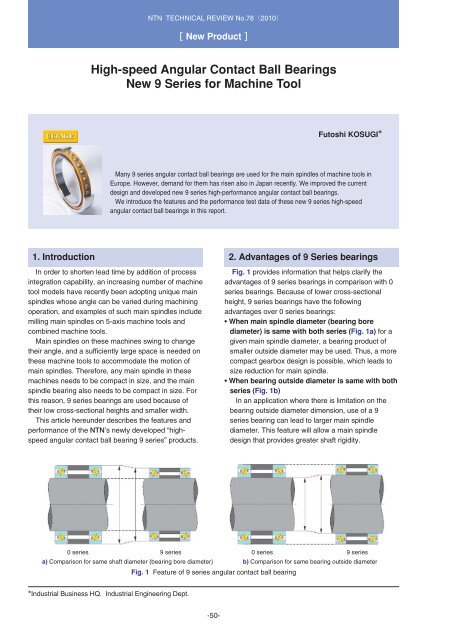
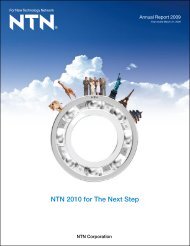
![[New Product] Unit Products for Office Equipment - NTN](https://img.yumpu.com/27154451/1/184x260/new-product-unit-products-for-office-equipment-ntn.jpg?quality=85)
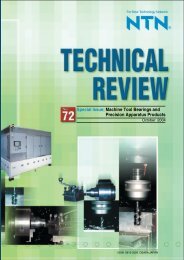
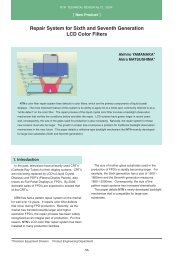
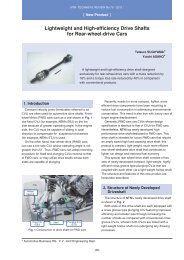
![[New Product] Development of Oil-impregnated Sintered ... - NTN](https://img.yumpu.com/27154427/1/184x260/new-product-development-of-oil-impregnated-sintered-ntn.jpg?quality=85)
